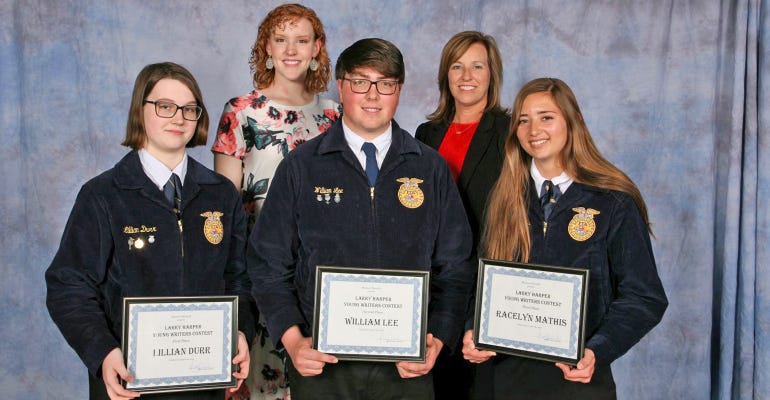May 17, 2019

Editor’s note: Each year, Missouri Ruralist sponsors the Larry Harper Young Writers Contest. This year, we asked FFA members to share ways to solve the hunger crisis in rural America. Winners were announced April 26 at the Missouri State FFA Convention. Here is the top essay from the contest.
By Lillian Durr
An issue commonly presented to agriculturalists is the future need for food. According to Time Magazine, “By 2050, with the global population expected to reach 9.8 billion, our food supplies will be under far greater stress. Demand will be 60% higher than it is today, but climate change, urbanization and soil degradation will have shrunk the availability of arable land, according to the World Economic Forum.” This is foreboding.
Our world already experiences such a potent issue of food insecurity, with more than 815,000,000 people suffering from hunger in 2016. This approaching crisis means that not only will the agricultural industry have to produce significantly more food, it will have to do so without increased resources.
In order to lessen the impact of these rising issues, I believe that as an industry agriculture must decrease the amount of food wasted, while still working to maximize the efficiency of land use.
Local issue
In the matter of diminishing food waste, I see the primary effort as most effective when enacted on the local level.
An example of a community’s involvement in waste reduction can take place in any school through a food recycling station. A food recycling station is a table or counter in the cafeteria on which students can leave uncontaminated, unwanted items from their lunch, such as apples, milk cartons, cookies, bags of chips or salads. This simultaneously provides food for those who may be hungry, while also preventing food from being discarded.
My own school has greatly benefited from the introduction of a food recycling station. As for how other schools could become involved, FFA chapters, or similarly agriculturally based organizations like 4-H, could become involved in this endeavor, by either organizing the station themselves, or simply by encouraging their fellow students to contribute to the effort rather than simply throwing away unwanted items.

WORD MASTERS: Pictured are the winners of the Missouri Ruralist Larry Harper Young Writers Contest awards at the 91st Missouri FFA Convention: (front row from left) Lillian Durr, Pleasant Hope FFA Chapter, first place; William Lee, Warrenton FFA Chapter, second place; Racelyn Mathis, Carrollton ACC FFA Chapter, third place; (back row from left) Elizabeth Wyss, Missouri Ruralist College Farmer columnist; Mindy Ward, Missouri Ruralist editor.

International response
While the matter of reducing food waste is one that can be approached at the local level, the issue of fully utilizing available land is much larger in scale.
The first resource that is severely lacking compared to the current need is arable land. However, I believe a potential solution managing the lack of arable land is by innovating through vertical farming.
Vertical farming is a newfound way of utilizing not only open rural spaces for farming, but also urban areas. According to the article ‘What is Vertical Farming?’, a vertical farm grows plants and produce by stacking the plants. This is accomplished by using growing shelves suspended on a wall or fence, which uses much less space than growing the plants on the ground, thereby maximizing the available space.
This practice would greatly increase the area available for growing crops. Not only would it increase the amount of available land, but also vertical farming yields more crops per square meter than traditional farming or greenhouses do, according to a BBC report “How Vertical Farming Reinvents Agriculture.”
It also states vertical farming uses less water, grows plants faster and can be used year-round — not just in certain seasons.
United effort
Missouri could play an incredible role in introducing this innovative technique to popular agriculture by implementing vertical farming in urban areas, such as St. Louis, Kansas City and Springfield.
Food insecurity is a many layered issue. However, there are steps that can be taken to reduce its potency. By working to prevent hunger on a local, state, national and global level, the number of people who go hungry can be greatly reduced, but in order to do so food waste must be greatly decreased, and the available resources must be fully utilized.
Durr writes from Pleasant Hope, Mo.
You May Also Like




